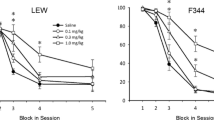Abstract
The behavioral effects of cholinergic agonists and antagonists were examined in two lines of rats which have been developed through selective breeding techniques to be differentially sensitive to the anticholinesterase diisopropyl fluorophosphate (DFP). The line of rats which were determined to be more sensitive to DFP (Flinders S line) were also more sensitive to the depressant effects of the agonists pilocarpine and physostigmine on locomotor activity, water intake, and operant responding maintained by water reward. In contrast, the locomotor stimulant effects of scopolamine, a muscarinic antagonist, were less marked in the S-line rats, while the depressant effects of atropine and scopolamine on water intake and operant responding maintained by water reward were comparable in the two lines. The S-line rats were also significantly more sensitive to the hypothermic effects of pilocarpine and oxotremorine. These findings are consistent with the hypothesis that the S-line rats are more sensitive to the acute effects of DFP because they have a higher number of muscarinic-cholinergic receptors.
Similar content being viewed by others
References
Broadhurst PL (1978) Drugs and the inheritance of behavior. Plenum Press, New York
Bunney WE, Post RM, Andersen AE, Kopanda RT (1977) A neuronal receptor sensitivity mechanism in affective illness. Commun Psychopharmacol 1:393–405
Chippendale TJ, Zawolkow GA, Russell RW, Overstreet DH (1972) Tolerance to low cholinesterase levels: Modification of behavior without acute behavioral change. Psychopharmacologia 26:127–139
Christie MJ, Overstreet DH (1979) Sensitivity of morphine-tolerant rats to muscarinic and dopaminergic agonists: Relation to tolerance or withdrawal. Psychopharmacology 65:27–34
Cox B, Lee TF (1978) Is acetylcholine involved in a dopamine receptor mediated hypothermia in mice and rats? Br J Pharmacol 62:339–397
Creese I, Sibley DR (1981) Receptor adaptations to centrally acting drugs. Annu Rev Pharmacol Toxicol 21:357–391
Cross AJ, Crow TJ, Owen F (1981) 3H-Flupenthixol binding in postmortem brains of schizophrenia: Evidence for a selective increase in dopamine D2 receptors. Psychopharmacology 74:122–124
Driscoll P, Dedek J, Martin JR, Battig K (1980) Regional 5-HT analysis in Roman high-avoidance and low-avoidance rats following MAO inhibition. Eur J Pharmacol 68:373–376
Ehlert FJ, Kokka N, Fairhurst A (1980) Altered quinuclidinyl H-3-benzilate binding in the striatum of rats following chronic cholinesterase inhibition with diisopropyl fluorophosphate. Molec Pharmacol 17:24–30
Lee T, Seeman P (1979) Elevation of brain neuroleptic/dopamine receptors in schizophrenia. Amer J Psychiat 137:191–197
Martin JR, Overstreet DH, Driscoll P, Battig K (1981) Effects of scopolamine, pilocarpine, and oxotremorine on the exploratory behavior of two psychogenetically selected lines of rats in a complex maze. Psychopharmacology 72:135–142
Netherton RA, Overstreet DH (1981) Sex-dependent hypothermic effects of cholinergic agonists. International Union of Pharmacology 8:628
Oppenoorth FS, Smissaert HR, Wolling W, Van der Pas LJT, Hitman KT (1977) Insensitive AChE, high glutathione S-transferase and hydrolytic activity as resistance factors in a tetrachlorvinphosresistant strain of housefly. Pest Biochem Physiol 7:34–47
Overstreet DH, Hadick DG, Russell RW (1972) Effects of amphetamine and pilocarpine on eating behavior in rats with chronically low acetyl-cholinesterase. Behav Biol 7:217–226
Overstreet DH, Kozar MD, Lynch GS (1973) Reduced hypothermic effects of cholinomimetic agents following chronic anticholinesterase treatment. Neuropharmacology 12:1017–1032
Overstreet DH, Russell RW, Vasquez BJ, Dalglish FW (1974) Involvement of muscarinic and nicotinic receptors in behavioral tolerance to DFP. Pharmacol Biochem Behav 2:45–54
Overstreet DH, Russell RW, Helps SC, Runge P, Prescott AM (1979a) Sex differences following pharmacological manipulation of the cholinergic system by DFP and pilocarpine. Psychopharmacology 61:49–58
Overstreet DH, Russell RW, Helps SC, Messenger M (1979b) Selective breeding for sensitivity to the anticholinesterase, DFP. Psychopharmacology 65:15–20
Overstreet DH, Yamamura HI (1979) Receptor alterations and drug tolerance. Life Sci 25:1865–1878
Overstreet DH, Driscoll P, Martin JR, Yamamura HI (1981a) Brain muscarinic cholinergic receptor binding in Roman high- and low-avoidance rats. Psychopharmacology 72:143–145
Overstreet DH, Russell RW, Kerni W, Netherton RA (1981b) The influence of ovariectomy on the sex-dependent effects of the anticholinesterase, diisopropyl fluorophosphate. Psychopharmacology 74:391–392
Rainbow TC, Degroff V, Luine VN, McEwen BS (1980) Estradiol 17β increases the number of muscarinic receptors in hypothalamic nuclei. Brain Res 198:239–244
Riley EP, Freed EL, Lester D (1975) Selective breeding of rats for differences in reactivity to alcohol: An approach to an animal model of alcoholism. I. General procedures. J Stud Alc 37:1535–1547
Roderick TH (1960) Selection for cholinesterase activity in the cerebral cortex of the rat. Genetics 45:1123–1140
Russell RW, Overstreet DH, Cotman CW, Carson VG, Churchill L, Dalglish FW, Vasquez BJ (1975) Experimental tests of hypotheses about neurochemical mechanisms underlying behavioral tolerance to the anticholinesterase, DFP. J Pharmacol Exp Ther 192:73–85
Russell RW (1982) The cholinergic system: Search for mechanisms of action. Annu Rev Pharmacol Toxicol 22:435–463
Schallert T, Overstreet DH, Yamamura HI (1980) Muscarinic receptor binding and behavioral effects of atropine following chronic catecholamine depletion or acetylcholinesterase inhibition in rats. Pharmacol Biochem Behav 13:187–192
Schiller GD (1979) Reduced binding of 3H-quinuclidinyl benzilate associated with chronically low acetylcholinesterase activity. Life Sci 24:1149–1154
Smee ML, Overstreet DH (1976) Alterations in the effects of dopamine agonists and antagonists on general activity in rats following chronic morphine treatment. Psychopharmacology 49:125–130
Vasquez BJ, Overstreet DH, Russell RW (1974) Psychopharmacological evidence for increase in receptor sensitivity following chronic morphine treatment. Psychopharmacologia 38:287–302
Author information
Authors and Affiliations
Rights and permissions
About this article
Cite this article
Overstreet, D.H., Russell, R.W. Selective breeding for diisopropyl fluorophosphate-sensitivity: Behavioural effects of cholinergic agonists and antagonists. Psychopharmacology 78, 150–155 (1982). https://doi.org/10.1007/BF00432254
Received:
Accepted:
Issue Date:
DOI: https://doi.org/10.1007/BF00432254




